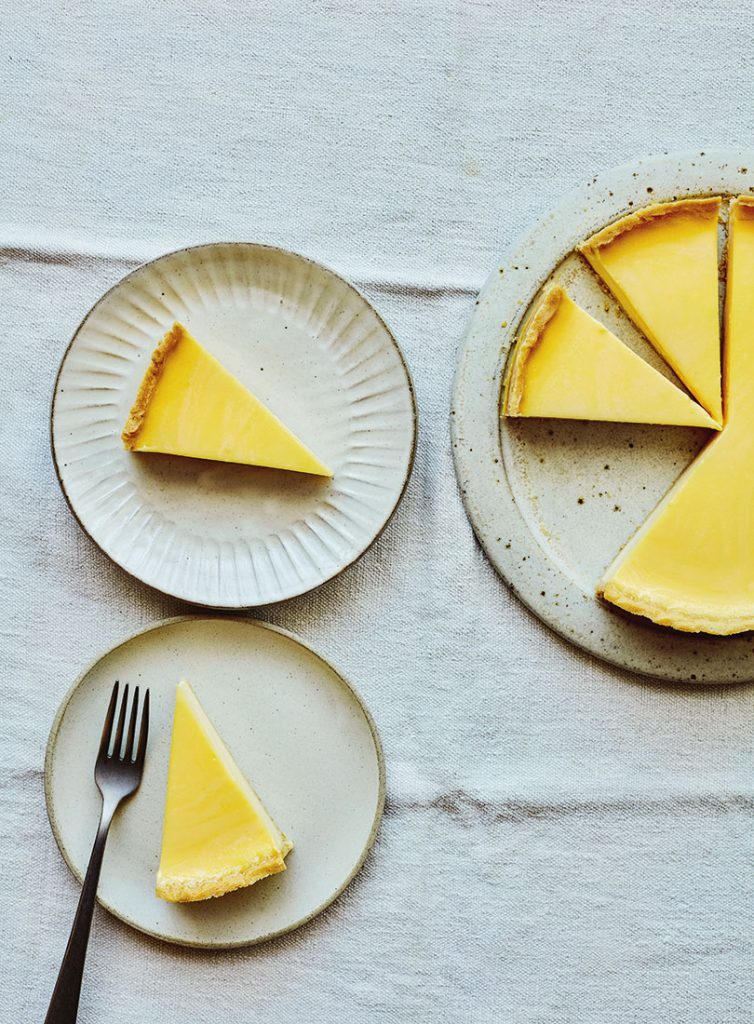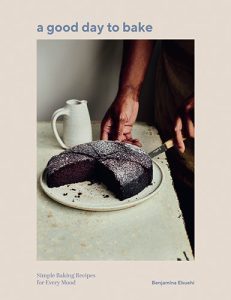Bay Leaf Custard Tart
Benjamina Ebuehi

Serves
8Ingredients
| FOR THE PASTRY | |
| 210g (7½oz/1½ cups) plain (all-purpose) flour, plus extra for dusting | |
| 60g (2¼oz/scant ½ cup) icing (confectioners’) sugar | |
| ¼ teaspoon salt | |
| 130g (4¾ oz/½ cup plus 1 tablespoon) unsalted butter | |
| 1 egg, separated | |
| 2–3 tablespoons ice-cold water | |
| FOR THE CUSTARD | |
| 250ml (9fl oz/generous 1 cup) milk | |
| 300ml (10½ fl oz/generous 1¼ cups) double (heavy) cream | |
| 8 fresh bay leaves | |
| 7 egg yolks | |
| 100g (3½oz/½ cup) caster (granulated) sugar |
There are quite a few custard-based recipes in this book, such is my love for the stuff in all of its glorious forms. And nothing quite beats a classic custard tart. Just infusing the cream with a few fresh bay leaves transforms this into something quite fragrant and almost tea-like. Bay leaves are an ingredient that tend to get thrown into a stew or soup without knowing what it actually tastes like. It’s not necessarily a flavour a lot of people could identify on its own. But here, woven into the silky custard, it sings. Fresh bay is a must here to really get the best flavour.
View the recipe collection here
Instructions
| 1. | Add the flour, icing sugar, salt and butter to the bowl of a food processor and pulse until you have fine breadcrumbs. (If making by hand, rub the butter into the flour until fine.) |
| 2. | Add the egg yolk and a tablespoon of ice-cold water and pulse until it starts to clump, adding more water, a tablespoon at a time, if needed. |
| 3. | Turn the dough out onto a lightly floured surface and pat it into a thick disc. |
| 4. | Wrap it in plastic wrap and let it rest in the refrigerator for 1 hour, or until well chilled and firm. |
| 5. | Meanwhile, make the custard. Add the milk, cream and bay leaves to a small saucepan and heat gently until steaming, just before the boil. |
| 6. | Remove from the heat, cover and let the cream infuse for 30 minutes–1 hour. |
| 7. | Preheat the oven to 190°C (170°C fan/375°F/gas mark 5). |
| 8. | Lightly dust your work surface with flour and roll out the pastry to 3–4mm (⅛in) thick. |
| 9. | Line a 20-cm (8-in) tart pan or loose-bottomed cake pan with the pastry, making sure to press the pastry evenly into the edges and leaving an overhang of pastry around the rim. |
| 10. | Prick the base of the pastry a few times with a fork, then pop it in the freezer for 15 minutes. |
| 11. | Once chilled, use a small, sharp knife to trim off the overhanging pastry to give a neat crust. |
| 12. | Scrunch up a piece of baking paper, open it out again and use it to line the inside of the tart. |
| 13. | Fill with baking beans or uncooked rice and blind bake for 20 minutes. |
| 14. | Carefully remove the baking beans and paper and continue to bake for another 15–22 minutes, until the edges have browned and the base is firm to the touch. |
| 15. | Brush the base with a little bit of the egg white and put back in the oven for 2 minutes – this will help create a seal for the custard. Remove from the oven and leave to cool. |
| 16. | Reduce the oven to 150°C (130°C fan/300°F/gas mark 2). |
| 17. | To finish the custard, in a separate bowl, whisk the egg yolks and sugar together until combined. |
| 18. | Strain the bay leaves from the saucepan and return the cream to the pan. Gently bring to the boil. |
| 19. | Pour the hot cream into the egg mixture, whisking to combine, then pass the custard through a fine sieve (strainer) to catch any little lumps. |
| 20. | Pour half of the custard into the pastry shell and skim off and discard any foam on the top. |
| 21. | Place the tart on a baking sheet and into the oven. |
| 22. | Pour in the rest of the custard and bake for 30–40 minutes until just set with a jelly-like wobble in the middle. |
| 23. | Remove from the oven and leave to cool completely. |
| 24. | Serve at room temperature or chilled. |
 This is an edited extract
This is an edited extract
from A Good Day to Bake
by Benjamina Ebuehi,
published by Quadrille
Publishing, RRP $45.00.
Available in stores
nationally. Photography
by Laura Edwards.
